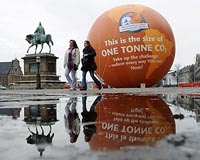| . |  |
. |
Cancun, Mexico (AFP) Nov 26, 2010 Global talks on climate change resume in the Mexican resort of Cancun on Monday, facing a clamour for results or the prospect of limbo. The 12-day meeting climaxes an 11-month effort to pick up the pieces after last December's trauma in Copenhagen. More than 120 leaders jetted to the Danish capital, expecting to bless a pact that would slow, halt and then reverse the threat to Earth's climate system. Instead, they were plunged into a nightmare where they had to haggle over a horribly complex, fiercely disputed deal as the clock ticked away. Face was saved by the "Copenhagen Accord," cobbled together by a couple of dozen leaders, setting an aim of limiting warming to two degrees Celsius (3.6 degrees Fahrenheit) but lacking key details about how to achieve it. Shocked and widely ridiculed, the 194 parties to the UN Framework Convention on Climate Change (UNFCCC) have since then taken a low-key, unfailingly pragmatic tack. In a sign thereof, Cancun will end with talks at ministerial level, not heads of state or government. "One of the things that is at stake in Cancun is the legitimacy and credibility of the UN process," said Elliot Diringer of the US thinktank, the Pew Center on Global Climate Change. "If you have a second failure in the process, you may see parties start to withdraw from the process. I don't mean from the (UN Framework) Convention (on Climate Change), but to begin to look elsewhere for making progress." Frustrated by the snail's pace and labyrinthine meanderings, countries could be lured by smaller, nimbler fora such as the G20, he said. They could also be tempted to launch sectoral negotiations that cover specific carbon-spewing industries, such as power, transport and steelmaking. In the new post-Copenhagen age, there is no expectation of sealing a post-2012 treaty in Cancun, and talk of wrapping it all up in South Africa at the end of 2011 has also been sidelined. Indeed, bolder minds do not even want to pronounce the "T" word, given the task of stitching together an all-embracing treaty stuffed with so many connected issues, with every risk that it could be unravelled by national interests. Instead, the new approach is to secure visible progress on separate operational issues and then ratchet up these measures, bit by bit, in successive rounds of talks. "One of the big lessons from Copenhagen that countries have actually learned from themselves is that there is no such thing as one all-encompassing solution," UNFCCC Executive Secretary Christiana Figueres told reporters this month. "They also seem to be setting out to develop the building blocks upon which they can build realistic action on the ground, because countries really need results on the ground right now." A European negotiator said the new credo was "bottom up" (progress on the ground) as opposed to "top down," or a treaty. "There are big weaknesses in it, but it's political reality and we have to deal with it," he said. Cancun could unlock action in several important areas, he said. The one likeliest to make headlines is the launch, even symbolic, of a so-called "Green Fund" to help poor, climate-vulnerable countries. It could be the main vehicle for aid, promised by rich countries in Copenhagen, that could reach as much as 100 billion dollars a year by 2020. Another area of progress is a deal on financial help to prevent tropical deforestation. Logging and conversion of forests to agriculture or habitation accounts for 12 percent of greenhouse-gas emissions. The prospects for dealmaking remain troubled, though, by tensions between China and the United States, the world's No 1. and No. 2 emitters, who between them account for 41 percent of all fossil-fuel carbon pollution. China is irked by US demands to submit its emissions pledges to international scrutiny, even though Washington's own emissions plans are unambitious and at threat from conservatives in Congress. At UNFCCC talks in Tianjin in October, China's chief climate negotiator, Su Wei, likened the US stance to "a pig looking in a mirror" and finding itself beautiful. "Both the US and China are doing their best that in the event of a failure, it will be the other who gets blamed," said Diringer.
Share This Article With Planet Earth
Related Links Climate Science News - Modeling, Mitigation Adaptation
 UN body warns Copenhagen climate targets could be missed
UN body warns Copenhagen climate targets could be missedHelsinki (AFP) Nov 23, 2010 The Copenhagen accord targets to cut global warming will be missed unless next week's climate change conference transforms promises into action, the United Nations Environment Programme (UNEP) said Tuesday. Representatives from 194 countries meet in the Mexican resort city of Cancun from November 29 to December 10 for a new bid to strike a deal to curb greenhouse gases following on last Dece ... read more |
|
| The content herein, unless otherwise known to be public domain, are Copyright 1995-2010 - SpaceDaily. AFP and UPI Wire Stories are copyright Agence France-Presse and United Press International. ESA Portal Reports are copyright European Space Agency. All NASA sourced material is public domain. Additional copyrights may apply in whole or part to other bona fide parties. Advertising does not imply endorsement,agreement or approval of any opinions, statements or information provided by SpaceDaily on any Web page published or hosted by SpaceDaily. Privacy Statement |